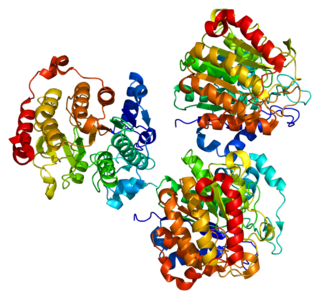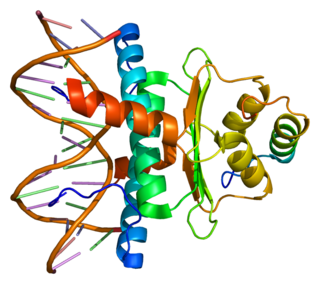Histone deacetylase 4, also known as HDAC4, is a protein that in humans is encoded by the HDAC4 gene. [5] [6]
Histone deacetylase 4, also known as HDAC4, is a protein that in humans is encoded by the HDAC4 gene. [5] [6]
Histones play a critical role in transcriptional regulation, cell cycle progression, and developmental events. Histone acetylation/deacetylation alters chromosome structure and affects transcription factor access to DNA. The protein encoded by this gene belongs to class II of the histone deacetylase/acuc/apha family. It possesses histone deacetylase activity and represses transcription when tethered to a promoter. This protein does not bind DNA directly but through transcription factors MEF2C and MEF2D. It seems to interact in a multiprotein complex with RbAp48 and HDAC3. [7] Furthermore, HDAC4 is required for TGFbeta1-induced myofibroblastic differentiation. [8]
Studies have shown that HDAC4 regulates bone and muscle development. Harvard University researchers also concluded that it promotes healthy vision: Reduced levels of the protein led to the death of the rod photoreceptors and bipolar cells in the retinas of mice. [9] [10]
HDAC4 has been shown to interact with:

Histone deacetylase 1 (HDAC1) is an enzyme that in humans is encoded by the HDAC1 gene.

The nuclear receptor co-repressor 1 also known as thyroid-hormone- and retinoic-acid-receptor-associated co-repressor 1 (TRAC-1) is a protein that in humans is encoded by the NCOR1 gene.

The nuclear receptor co-repressor 2 (NCOR2) is a transcriptional coregulatory protein that contains several nuclear receptor-interacting domains. In addition, NCOR2 appears to recruit histone deacetylases to DNA promoter regions. Hence NCOR2 assists nuclear receptors in the down regulation of target gene expression. NCOR2 is also referred to as a silencing mediator for retinoid or thyroid-hormone receptors (SMRT) or T3 receptor-associating cofactor 1 (TRAC-1).

Histone deacetylase 2 (HDAC2) is an enzyme that in humans is encoded by the HDAC2 gene. It belongs to the histone deacetylase class of enzymes responsible for the removal of acetyl groups from lysine residues at the N-terminal region of the core histones. As such, it plays an important role in gene expression by facilitating the formation of transcription repressor complexes and for this reason is often considered an important target for cancer therapy.

Histone deacetylase 3 is an enzyme encoded by the HDAC3 gene in both humans and mice.

Paired amphipathic helix protein Sin3a is a protein that in humans is encoded by the SIN3A gene.

Histone-binding protein RBBP4 is a protein that in humans is encoded by the RBBP4 gene.

Myocyte-specific enhancer factor 2C also known as MADS box transcription enhancer factor 2, polypeptide C is a protein that in humans is encoded by the MEF2C gene. MEF2C is a transcription factor in the Mef2 family.

Histone deacetylase 6 is an enzyme that in humans is encoded by the HDAC6 gene. HDAC6 has emerged as a highly promising candidate to selectively inhibit as a therapeutic strategy to combat several types of cancer and neurodegenerative disorders.

The testicular receptor 2 (TR2) also known as NR2C1 is protein that in humans is encoded by the NR2C1 gene. TR2 is a member of the nuclear receptor family of transcription factors.

C-terminal-binding protein 1 also known as CtBP1 is a protein that in humans is encoded by the CTBP1 gene. CtBP1 is one of two CtBP proteins, the other protein being CtBP2.

Myocyte-specific enhancer factor 2A is a protein that in humans is encoded by the MEF2A gene. MEF2A is a transcription factor in the Mef2 family. In humans it is located on chromosome 15q26. Certain mutations in MEF2A cause an autosomal dominant form of coronary artery disease and myocardial infarction.

Histone deacetylase 5 is an enzyme that in humans is encoded by the HDAC5 gene.

Histone deacetylase 9 is an enzyme that in humans is encoded by the HDAC9 gene.

Myocyte-specific enhancer factor 2D is a protein that in humans is encoded by the MEF2D gene.

Histone deacetylase 7 is an enzyme that in humans is encoded by the HDAC7 gene.

Sin3A-associated protein, 30kDa, also known as SAP30, is a protein which in humans is encoded by the SAP30 gene.

Paired amphipathic helix protein Sin3b is a protein that in humans is encoded by the SIN3B gene.

Calcineurin-binding protein cabin-1 is a protein that in humans is encoded by the CABIN1 gene.

Transducin (beta)-like 1X-linked, also known as TBL1X, is a protein which in humans is encoded by the TBL1X gene.
This article incorporates text from the United States National Library of Medicine, which is in the public domain.